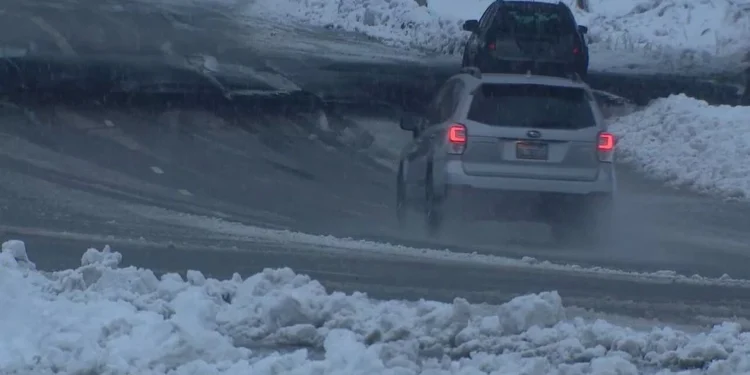Snow blanketed the Cascade Mountains and Snoqualmie Pass over the weekend and Monday morning, prompting winter driving reminders for motorists.
Skiing and snowboarding slopes remain closed, but drivers crossing Snoqualmie Pass now or in coming months should know the following:
You must carry tire chains in your vehicle starting November 1. Even if chains aren’t needed on your tires, getting pulled over without a set in your car results in a $500 fine.
You can use studded tires starting November 1 through March 31. The Washington Department of Transportation recommends stud-free winter tread traction tires, which provide more aggressive grip and cause less road damage.
Driving from Seattle over Snoqualmie Pass on Interstate 90, the first warning about snowy, icy, and slushy conditions appears approximately 25 miles from West Summit. Roads became more treacherous only two to three miles out.
“I see people spin out all the time,” said Spencer Meckley, bartender at The Commonwealth. “I’ve pulled people out of many ditches before in my truck. And it’s just respecting Mother Nature and making sure it’s bigger than you.”
Despite heavy snowfall being typical for the Cascade Mountains, some students heading to school Monday morning said the winter weather exceeded their expectations.
“I asked my mom, if I get ready fast enough for school, can I go outside and build a snowman? And then I did,” student Micah McBride said.
WSDOT officials said nearly 1,500 maintenance workers across the state are preparing roads for winter. Sheds are being stocked with salt and equipment, including 500 snow plows ready for deployment.
The weekend and Monday morning snowfall marking the season’s first major Cascade accumulation signals the transition from fall driving conditions to winter hazards requiring chains, winter tires, and increased following distances on mountain passes.
The November 1 mandatory chain possession date reflects historical weather patterns where Snoqualmie Pass typically experiences its first significant snowfall in early November, though climate variability means snow can arrive earlier or later than average.
The $500 fine for lacking chains even when not required on tires emphasizes Washington’s strict winter preparedness enforcement, with State Patrol targeting unprepared drivers who create traffic hazards when conditions deteriorate and they cannot install chains.
The studded tire authorization from November 1 through March 31 balances traction benefits for drivers navigating icy roads against pavement damage studded tires inflict, with the five-month window covering peak winter months when studs provide safety advantages.
WSDOT’s recommendation favoring stud-free winter tread traction tires over studded versions reflects engineering studies showing modern rubber compounds and tread patterns achieve comparable grip without the metal studs that gouge pavement and create road maintenance costs.
The 25-mile advance warning distance from West Summit provides drivers substantial notice to reduce speed and increase alertness before encountering hazardous conditions, though many motorists ignore early warnings and fail to adjust driving until roads visibly deteriorate.
The two-to-three-mile proximity to West Summit where roads became “more treacherous” indicates elevation-dependent snow accumulation, with the pass summit at 3,022 feet experiencing heavier precipitation than lower elevations where rain predominates.
Spencer Meckley’s bartender perspective witnessing frequent spinouts and conducting ditch extractions with his truck reflects the Commonwealth’s location near Snoqualmie Pass where service industry workers regularly observe tourist drivers unprepared for winter conditions.
The “respecting Mother Nature and making sure it’s bigger than you” philosophy articulates mountain driving humility that acknowledges human limitations against weather forces, contrasting with overconfident drivers who overestimate their vehicle capabilities and driving skills.
Micah McBride’s enthusiasm building a snowman before school captures childhood excitement about snowfall that adults often view as inconvenient, with the student’s bargain with his mother demonstrating how snow days create memorable experiences for mountain community children.
The 1,500 WSDOT maintenance workers statewide represent substantial workforce dedicated to winter road operations, with personnel distributed across multiple mountain passes, lowland highways, and urban corridors requiring snow and ice management.
The stockpiled salt and equipment preparation indicates WSDOT’s proactive approach filling storage sheds before winter storms arrive, avoiding scenarios where supply shortages during active weather events leave crews unable to treat roads effectively.
The 500 snow plows ready for deployment demonstrate fleet size necessary to maintain Washington’s extensive highway system, with multiple plows assigned to each major pass and urban interstate to provide continuous clearing during heavy snowfall.
The November timing for first major snowfall aligns with typical weather patterns though remains earlier than some years when significant accumulation doesn’t occur until December, creating variability that challenges WSDOT planning and motorist preparedness.
Seattle-area residents driving to Snoqualmie Pass for recreation or cross-state travel face the psychological adjustment from mild, rainy lowland conditions to snowy mountain environments just 50 miles away, requiring mental preparation and equipment checks before departure.
The Interstate 90 corridor over Snoqualmie Pass represents Washington’s primary east-west transportation route, with commercial trucking, commuter traffic, and recreational travelers all sharing roadways during winter conditions that create unique challenges for each user group.
The closed ski slopes despite snowfall indicate resorts await sufficient base depth and staffing preparation before opening, typically occurring in mid-to-late November when consistent cold temperatures maintain snow pack and lift operations commence.
The winter driving reminders serve annual public service function educating newcomers to Washington about mountain pass requirements while reminding veterans about legal obligations and safety practices that prevent accidents, delays, and citations.







